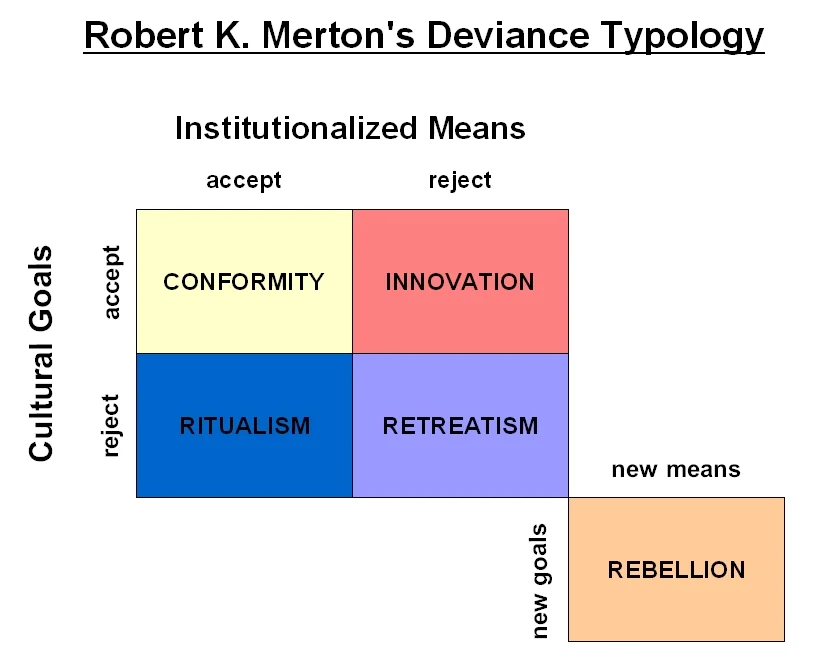Chapter 2 : Crime and Deviance
1/14
Earn XP
Description and Tags
2.1 How are crime and deviance defined and measured?
Name | Mastery | Learn | Test | Matching | Spaced |
|---|
No study sessions yet.
15 Terms
what are the ideas of classical criminology?
focuses on the crime
believes that there is no difference between a criminal and non-criminal (free will)
ensures that the punishment fits the crime
what are the ideas of positivism?
focuses on the criminal
believes that criminals are different (determinism)
ensures that the punishment / therapy suits the offender
what are the ideas of durkheim?
crime is a normal part of society
crime is not only influenced by economic factors, but also cultural factors
as modern societies become more individualised, crime may also decrease
what are the ideas of merton’s strain theory?
society has taught us goals (e.g. have money, power) but at the same time systematically blocked the opportunities for many people to achieve these goals
this leads to them being in the state of anomie
being in this state was more likely to lead to trying to achieve these goals through illegitimate means

what is meant by the term ‘anomie’ according to durkheim?
a breakdown of social norms
this will lead to individuals being in a state of confusion or sense of purposeless
they may feel disconnected from social values, goals and expectations of society
what is meant by the term ‘anomie’ according to merton?
when there is a gap between what they expect out of life and what they were actually getting
what are the ideas of subculture theory?
refers to a group of people who exist outside of mainstream culture (e.g. criminals)
might’ve started young by following parents before it turns to following peers
they form their own cultural frameworks that normalise deviant behaviour (e.g. breaking windows, stealing)
what are the ideas of interactionism?
focuses on the question ‘why are some actions seem as criminal/deviant in the first place and why are some individuals labelled as criminals’
moves from focusing on crime to deviance
moves from looking at criminal behaviour to looking at how society reacts
focuses more on the subjective experience, how agents of social control identify and reinforce behaviours that are deviant
suggests that being stereotyped or labelled as deviant or a criminal may in fact encourage them to reinforce the stereotype
what are the ideas of marxism/radical criminology?
argues that the injustice of capitalism is a cause of crime and deviance
we should not label the crimes of the lower class, their actions are the result of the conditions they are forced to live with
by identifying the crimes of lower class and allowing the media to create moral panic about it, it camouflages the crimes of the powerful (tax evasion, fraud)
the criminal becomes a critic of society, rebelling against the injustice of the capitalist system by committing crimes
what are the ideas of left realism?
people often romanticise a crime/deviance (making criminals appear more relatable by exaggerating their struggles, shifting the focus from their actions or motives)
many victims of crime are often working class (poor) or women, this could lead to people forgetting the victims
what are the ideas of right realism?
turned the question to ‘what can we do to try and control crime?’
wilson & kelling ‘broken windows’ theory
as fear builds up, informal social control goes down which allows petty crime to infiltrate
suggests methods such as zero tolerance policy and situational crime prevention
what does wilson & kelling state in ‘broken windows’ theory?
crime and disorder are closely related, the physical environment had an impact on fear of crime and the sense of safety
e.g. broken windows in houses → problem can escalate, leading to more serious crimes happening → a sense of unease from residents
what is the zero tolerance policy?
remove any physical or social cues within environments that cause fear
e.g. having harsh punishments for minor crimes such as graffitiing
what is situational crime prevention?
manipulating spaces and reducing crime without having to deal with the underlying causes of crime
e.g. installing CCTVs, adding barbed wires / gates as a deterrence
what is a crime?